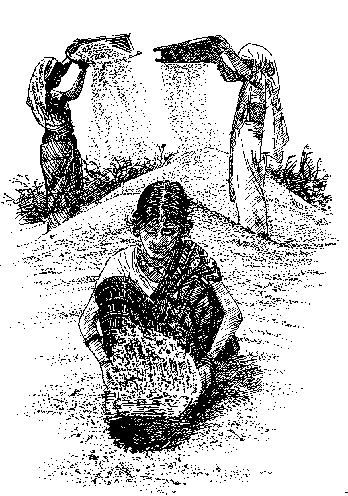Chapter 3. The Economy
Drying and sifting rice, Bangladesh's main staple
IN THE LATE 1980s, Bangladesh continued to be called the "largest poorest" country and to be singled out as "the test case for development." A great deal that had happened in the economy since independence in 1971 supported the hope that the country would eventually overcome its dependence on foreign aid and would approach relative self-sufficiency. In the meantime, success was measured in more limited and immediate accomplishments: greater production of food grains year by year, greater vigor shown by the private sector in generating investment capital and using it productively, and measurable growth and diversification of exports. The government continued to depend on the donor community to provide the bulk of the resources needed to promote human development in the form of nutrition, health, and education programs. The most active donors continued to give Bangladesh good marks for its economic performance.
In 1971, the year Bangladesh achieved independence from Pakistan, the new nation was referred to in foreign circles as an "international basket case," a wounded combatant almost beyond hope of recovery. Bangladeshis themselves, recalling the "international basket case" characterization, often choose the metaphor "bottomless basket," implying that no matter how much assistance is given to the economy, there will always be a need for more. It is a tribute to the Bangladeshi people, to the constructiveness and generosity of other nations, and to the strength of the human spirit that the gloomiest fears have not materialized. The firsttime observer of Bangladesh may still perceive the country as poverty stricken, overpopulated, and with little prospect for a sunnier future. In its first seventeen years of independence, Bangladesh did not prosper, nor was it able to improve substantially the quality of life for its huge population, but it did not lose ground either. If the prospects for rapid economic development were not noticeably better in 1988 than they were in 1972, it was encouraging that Bangladesh was active in economic fields that were not foreseen even a few years earlier--e.g., as a major producer and exporter of ready-made garments and frozen seafood. And if the economy still seemed dangerously poised on the brink of disaster--a drought, a typhoon, or excessive flooding threatens every year--the government, the people, and the international community had combined to limit the scope of disasters, and the economy of Bangladesh had continued to struggle upward.

